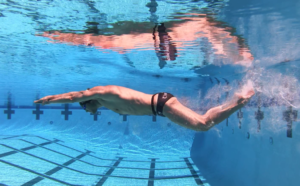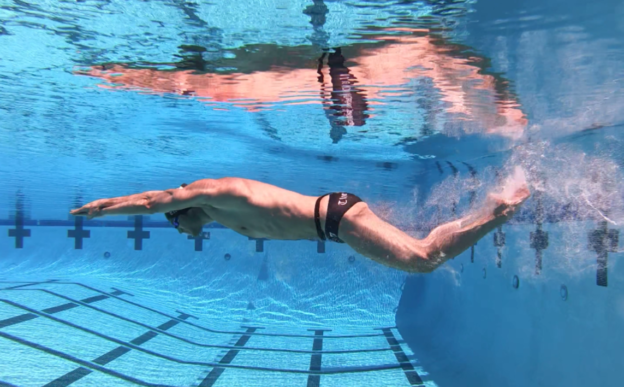Kicking Technique: Dolphin Kick Pop Quiz (correct answers are at the end)

How well do you understand Dolphin Kick?
Dolphin kick is now called the Fifth Stroke because it is such an important technique in all swimming races. It is a complex subject and not well understood by many. Test your knowledge about dolphin kick by taking this pop quiz. Let’s see how much you understand about the dolphin kick technique.
- During one kicking cycle, how many potential acceleration points (places that generate propulsion) are there?
- 1
- 2
- 3
- 4
- On one kicking cycle, how many major deceleration points (places where drag forces are much greater than propulsion) are there?
- 1
- 2
- 3
- 4
- In dolphin kick, the feet must move backward in the water in order to generate propulsion.
- True
- False
- On the down kick (while kicking on the stomach) the feet should be pointed straight backward.
- True
- False
- In dolphin down kick (while on stomach), nearly all of the propulsive force occurs at
- The Quadriceps
- The Hamstrings
- The Gastrocnemius (calf muscle)
- The Feet
- While dolphin kicking on the stomach, the greatest velocity can be achieved
- At the beginning of the down kick
- In the middle of the down kick
- Sometime during the up kick
- All of the above
- While dolphin kicking on the back, the peak velocity (highest velocity) is nearly always achieved
- During the down kick with the bottom of the feet moving downward
- At the beginning of the up kick with the top of the feet moving upward
- In the middle of the up kick when the body is more horizontal
- At the end of the up kick when the feet are above the hips
- The best time to initiate the first dolphin kick off each wall in a 100 yard freestyle is
- After a short glide
- After a long glide
- Immediately
- No dolphin kicks should be taken
- The first dolphin kick coming off the wall on a 100 freestyle is
- An up kick
- A down kick
- The ideal numbers of underwater dolphin kicks to be taken off the wall of each turn in the 100 freestyle is
- 1-2
- 2-3
- More than 3
- Unknown
- On a breaststroke pullout after the start, the legal number of dolphin down kicks that can be taken is
- 0
- 1
- 2
- 3
- The ideal knee bend before the down kick seems to be around
- 45-55 degrees
- 60-70 degrees
- 75-85 degrees
- 90 degrees
- Before the up kick, the ideal flexion of the hip seems to be around
- 10-15 degrees
- 15-20 degrees
- 20-30 degrees
- Over 30 degrees
- The recovery period on the dolphin kick should occur
- During the up kick
- After the down kick
- Before the down kick
- Never
- Dolphin kicking on the surface with a board is slower than dolphin kicking underwater
- True
- False
- While dolphin kicking under water, the hands and arms held tightly in a streamline position above the head should not move.
- True
- False
- Kicking dolphin underwater on the back is generally faster than dolphin kicking on the stomach.
- True
- False
- How many dolphin kicks are usually taken in a single butterfly stroke cycle?
- 1
- 2
- 3
- 4
- The biggest reason for deceleration caused from frontal drag at the end of the down kick is
- Too much hip flexion
- Not pointing the feet soon enough
- Waiting too long before initiating the next up kick
- Too much leg separation
- The size of the feet are the most important determinant of a swimmer’s dolphin kick speed
- True
- False
Answers to Dolphin Kick Quiz
- 4. Nearly all of the propulsion of the kick is generated by the feet. The feet use the vortices caused by the body moving forward through the water and the feet moving upward and downward to generate propulsion. While four potential points during the kicking cycle (two from the foot vortex and two from the body vortex), seldom do we see all four being used. More commonly, we see one, two or three points of acceleration actually happen.
- 2. The majority of the deceleration in dolphin kick is caused by the amount of knee bend (flexion) before the down kick and the amount of hip flexion and the duration and amount of the feet hanging before the up kick.
- 2 False. While the hands must move backwards in the water to generate propulsion, the feet are moving through water that is flowing or moving. Consequently, the feet can generate propulsion without moving backward relative to a fixed point in the pool. The direction of motion of the feet in dolphin kick is nearly straight up, then forward, then nearly straight down, then forward again. There is almost no backward motion of the feet during the dolphin kick.
- 2. False.
During the down kick, more propulsion can be generated by having the tops of the feet traverse the body vortex perpendicular to the slipstream, rather than parallel with the stream. To increase propulsion on the way down, the feet should turn inward, so called pigeon-toed plantar flexion.
- 4. Feet. Don’t confuse the muscles responsible for moving the hands and feet through the water with the location of the propulsive force itself. Remove the hands and feet from a swimmer and he or she will barely be able to make it down the pool.
- 4. All of the above.
Depending on where the swimmer puts forth the greatest effort, the peak acceleration and velocity can occur at the beginning of the down kick, through the body’s vortex on the way down, or during the up kick.
- 1. During the down kick. Because of the large foot vortex caused by the strong up kick and assistance of gravity, the down kick of a swimmer on his back becomes very powerful. Typically, we see the swimmer’s maximum speed reached during the down kick, not the up kick.
- 3. Immediately. Unless you are a Masters swimmer, when perhaps no dolphin kicks should be used, the best time to initiate the first kick is right when the toes leave the wall. The longer you glide, the slower your time will be to 5 meters.
- 2. Up kick. As the swimmer pushes off the wall, in order to maximize speed, the legs need to be straight and toes pointed. A down kick cannot be initiated until the knees are bent. Therefore, the first motion is always an up kick (albeit weak).
- 4. Unknown. The ideal number of dolphin kicks to be taken off each wall depends on the relative speed of the dolphin kick (on the stomach) versus the freestyle speed. These two speeds should be determined for 25 yards and then compared to arrive at the ideal number of dolphin kicks. The range is from zero to as many as needed to reach 15 meters underwater.
- 3. This is a trick question. Most swimmers and coaches do not recognize that the first dolphin kick on any start occurs when the feet first enter the water. With the angle of the body at entry the feet will generate propulsion as they move downward and forward. The swimmer is allowed to take one more down kick which is recommended while the arms are still in the streamline position, rather than simultaneously with the pulldown.
- 2. 60-70 degrees. To get meaningful propulsion on the down kick, the knees must bend. If they don’t bend enough, not enough propulsion is generated. If they bend too much, the swimmer will slow down too much before the next down kick. The ideal amount of knee bend depends on having good ankle plantar flexibility and seems to be in the range of 60-70 degrees.
- 3. 20-30 degrees. In order to get any meaningful propulsion during the up kick, swimmers need to flex their hips. Over flexing the hips will increase frontal drag and take too long. The ideal amount of hip flexion seems to be in the range of 20-30 degrees. However, to maximize the propulsion from the up kick, the swimmer must also point the toes backward and work hard on the upward motion.
- 4. Never. The fastest dolphin kickers work their legs and feet in both directions, up and down. If they delay too long in initiating either the down or up kicks, they lose the opportunity to use the foot vortex for more acceleration. There is no vacation time in fast dolphin kicking.
- 2. False. Being on the surface of the water, whether kicking or swimming, adds another component to frontal drag, called surface or wave drag. By kicking under water and eliminating surface drag, dolphin kicking beneath the surface is faster than on the surface.
- 2. False. During the dolphin kick the entire body, upper and lower, must move in order to maximize propulsion. If the arms and hands are held motionless in front of the swimmer, the hips are not being flexed. The ideal amount of movement of the hands back and forth seems to be around 6-8 inches.
- 1. True. While kicking on the back, the down kick, which is the weaker motion, becomes much stronger when compared to the same motion on the swimmer’s stomach. This results in a more uniform and higher velocity for the dolphin kicker on his back.
- 4. The up kicks in butterfly are often neglected. Yet they can be powerful if utilized. While it is desirable to use two strong down kicks in a fly, don’t forget about the up kicks. They count.
- 2. Not pointing the feet soon enough. Of all the technical errors made in swimming, allowing the feet to hang is one of the worst mistakes. It adds 41% more frontal drag compare to pointing the toes. One time we often see this mistake being made is at the end of the dolphin kick. Pointing the toes not only reduces frontal drag, and it will also help increase propulsion from the up kick.
- 2. False. While the size of the feet does matter, that is not as important as the ankle plantar flexion. Having lots of ankle plantar flexibility is a necessity to develop a fast dolphin kick. It does not guarantee it, however. Fast dolphin kick requires ankle flexibility, leg and back strength and tremendous leg fitness.
Yours in swimming,
Gary Sr.

